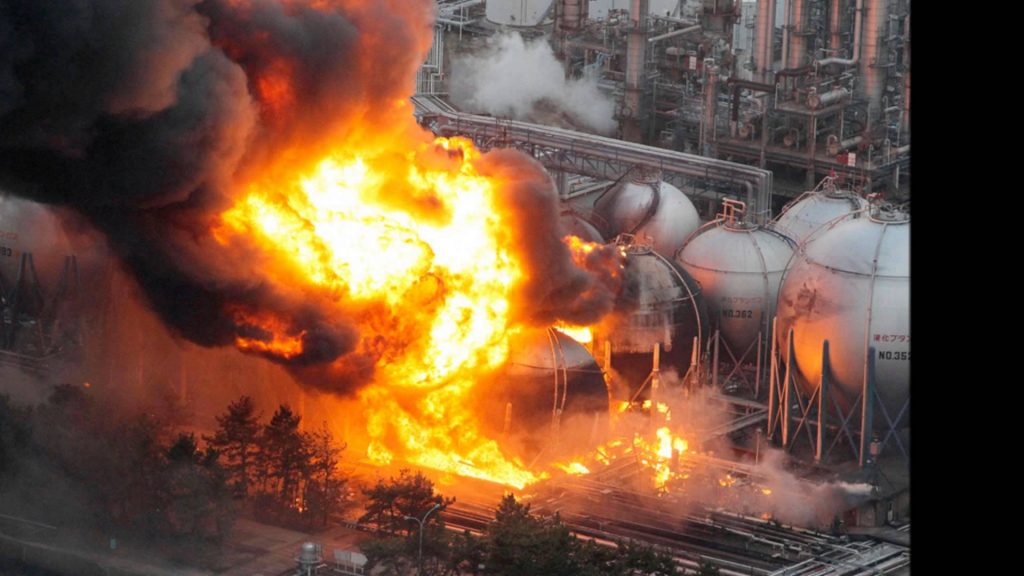Natural disasters are very common but tragic events around the world. From earthquakes to tornadoes, geological disasters can cause increasingly damaging effects, affecting the landscape and those who find themselves there. But when these events are combined with man-made artifacts, the effects might be even greater. An example of this is the Fukushima Disaster in Japan, the worst nuclear disaster since the 1986 Chernobyl incident.1 But the cause of this horrific disaster wasn’t particularly a man-made event. In fact, it all started with a wave.

On March 11, 2011, an earthquake with a magnitude 9.0—the worst to ever hit Japan—hit the country. It was such a powerful catastrophe, that Japan’s main island, Honshu, was permanently moved more than two meters to the east. As the earthquake gained momentum, waves up to 40 meters began crushing the country’s coast. The effects of the earthquake and the waves were too much for the Japanese. More than 20,000 people died or went missing and hundreds of thousands more lost their homes.2 But the worst was yet to come. Fifty minutes after the initial earthquake, a ten-meter high sea wall hit the Fukushima Daiichi (Number One) nuclear power plant. The water flooded the plant’s emergency power generators, knocking vital cooling systems offline, triggering a meltdown of reactor fuel rods. These then leaked deadly radiation into the coastal atmosphere of Japan. With the cooling systems not working, hydrogen gas built up in the reactor buildings, causing several hydrogen explosions in the following days of the earthquake.3

Because of the highly toxic radioactive material that leaked to the surrounding areas of the power plant, the government began to evacuate 80,000 people from a twelve-mile radius. Technicians turned to several things to try to cool the nuclear fuel, like using fresh water, seawater, and injecting nitrogen into the reactor containment buildings to prevent further explosions.4 But despite the efforts to try to help the people of Honshu, the government didn’t tell the people the truth. The official statistics of the event and even the admittance that the meltdown had taken place weren’t disclosed until eighty-eight days later.5
It was estimated that more than 800,000 tons of highly-radioactive material sat near the accident, which was slowly getting into the ground and moving towards the ocean. Although many people were evacuated, there were still many that couldn’t leave. The government installed temporary housing that was intended to house tens of thousands of people after the disaster for twenty-four months. But five years after the disaster, thousands of people were still living where they were surrounded by the radioactive material. Many of those who remained were the elderly and low-income families who had few options to move away.6

Several months after the disaster, people in other parts of Japan began rallying to help these people and bring an end to nuclear power plants in Japan. This pushed forward for the closure of all of the other nuclear plants in Japan for maintenance and inspection.7 These protests also pressured the government to issue a report on the disaster at Fukushima. This report criticized TEPCO (the Tokyo Electric and Power Company) for failing to address concerns about safeguards at the plant. This report also included information about how TEPCO officials had ignored engineers’ concerns that a seawall constructed to protect against major tsunamis as they had seen on March 11 was not sufficient. The report additionally criticized safety regulators for not implementing proper safety measures and for failing to adopt global nuclear safety standards.8 This was really important for the Japanese because TEPCO had always emphasized that the nuclear generators were “fail-safe,” that the facility was completely earthquake resistant and that the reactors would be able to withstand a major tremor.9
Five years after the disaster in Japan, several policies were changed to address the rising concerns of the Japanese population regarding nuclear power plants. The major decision of this kind was the decision to phase-out nuclear power plants during the 2030s as part of Innovative Strategy for Energy and the Environment adopted by the cabinet of the Democratic Party of Japan (DPJ).10 TEPCO is still facing criticism regarding the amount of nuclear material that was leaked into the environment and it is estimated that cleanup operations could take up to forty years.11
- Will Ripley, Junko Ogura, and James Griffiths, “Fukushima: Five Years after Japan’s Worst Nuclear Disaster,” CNN, March 11, 2016, sec. World. ↵
- Encyclopedia Britannica, 2018, s.v. “Fukushima Accident.” ↵
- New World Encyclopedia, 2017, s.v. “Fukushima nuclear disaster.” ↵
- New World Encyclopedia, 2017, s.v. “Fukushima nuclear disaster.” ↵
- Will Ripley, Junko Ogura, and James Griffiths, “Fukushima: Five Years after Japan’s Worst Nuclear Disaster,” CNN, March 11, 2016, sec. World. ↵
- Will Ripley, Junko Ogura, and James Griffiths, “Fukushima: Five Years after Japan’s Worst Nuclear Disaster,” CNN, March 11, 2016, sec. World. ↵
- New World Encyclopedia, 2017, s.v. “Fukushima nuclear disaster,” ↵
- Encyclopedia Britannica, 2018, s.v. “Fukushima Accident.” ↵
- Akira Nakamura and Masao Kikuchi. “What We Know, and What We Have Not Yet Learned: Triple Disasters and the Fukushima Nuclear Fiasco in Japan,” Public Administration Review 71, no. 6 (2011): 894. ↵
- Rie Watanabe, “After the Fukushima Disaster: Japan’s Nuclear Policy Change from 2011 to 2012,” Review Of Policy Research 33, no. 6 (2016): 623. ↵
- Alexis Dudden, “The Ongoing Disaster,” The Journal of Asian Studies 71, no. 2 (2012): 349. ↵




111 comments
Dylan Sanchez
Such a very informative articles that not only emphasized the catalyst of this catastrophe but also focused on how the catalyst could have been disregarded had TEPCO kept their word. The amount of lives that could have been saved had TEPCO not ignored the safety recommendations. Let this be a lesson to companies everywhere to be better safe than sorry.
Lyzette Flores
Oh my gosh, this is really crazy! From having an earthquake to a nuclear disaster must have been terrifying. I’m glad that the Japanese took action right away as soon as they heard about the nuclear plants. In my opinion, I don’t think the government should have hidden the news from the public because maybe if they would have known they could have taken different routes to the situation. I know they didn’t want to tell them because they didn’t want to freak the people out but it would have been nice to know with something very atrocious as this.
Julia Deais
I personally do not remember this, but it is a tragic event. My position on this is that the government could have prevented this whole thing from occurring. I feel like if they are gonna put a power plant somewhere they should first go over all the possibilities and if there is that one percent of something going wrong, then not put it in that location. Because of the unawareness, more than 20,000 families and friends were hurting after this event. This event could have been prevented, but it is a learning event. I am glad that they are planning on shutting down the other ones but they should have known the consequences before a tragic event occurred.
Christopher Hohman
Nice article. I do not remember the Fukishima disaster. A wave can cause that much destruction. wow just wow. The poor people who were affected by the disaster had enough on their plates without having to worry about nuclear meltdowns. And then it happened. It is terrible that Fukishima is second only to Chernobyl. I am glad to hear that the Japanese plan to phase out nuclear power and search for other options. I think that even though Nuclear power does have some benefits, the risk greatly outweigh the reward. It may be impossible to realize the full scope of the disaster until years later
Luis Magana
Disasters never leave you with a good impression because we live on this Earth and it could happen to almost anyone. There is currently a hurricane right now and I am afraid of the people who will be affected by it. Its terrible that Japan didn’t have one disaster but two. First the earthquake, a tsunami then the power plants. The aftermath is horrible and could take years for everything to be as it once was. The impact was so hard it moved the main island a couple meters east. The article is beautifully written but what a tragedy.
Cooper Dubrule
Its unfortunate that an event like this would happen and they rarely get this bad. Only a couple nuclear disasters have happened in history and their effects on the environment around the plant are very serious. I like how the people of Japan took action after the disaster and made sure the nuclear power plants were safe and eventually to get rid of them altogether in the future.
Jose Sanchez
This article flowed very well together and was very informative. I feel very disappointed and shocked by the lack of accountability and lack of action taken by the Japanese government and TEPCO. Nuclear power although a very effective method of attaining power, is very dangerous and measures should be taken to prepare for the worst-case scenario. Unfortunately, the Japanese government was not prepared.
Robert Rees
Great article and very informative. I do recall seeing both the earthquake and the reactor fallout in the news, however I do not remember hearing about exactly how severe it was. Reading that as much as eight hundred thousand tons of waste spilled into the sea and land, and that this clean would take over forty years to complete really helps put into perspective the damage this tsunami caused. It is obvious a lot of time and effort went into researching this topic, including what images to use as the last two images do well to show the scale of the disaster.
Dylan Coons
Great article. It’s odd how such a clean and productive source of energy can be so devastating when not kept in check. It’s too bad they never got the wake-up call to fix the numerous problems at the plant. If they weren’t so careless, this whole event could have been avoided. I don’t remember the media mentioning the plant’s lack of safety regulations, which would have been something worth mentioning and after the event happened.
Montserrat Moreno Ramirez
40 years of cleanup operation? That’s a big price to pay for not having the right policies or security measures in the first place. I mean no one can predict natural disasters but in my opinion a nuclear plant should consider all possible outcomes. It’s awful to just imagine what all those people went through.